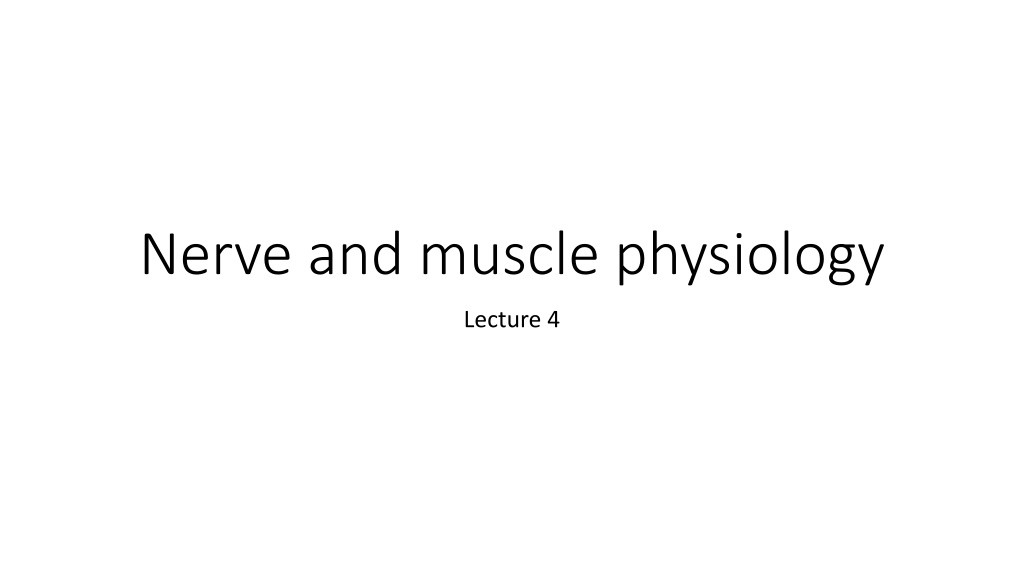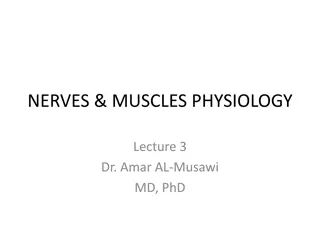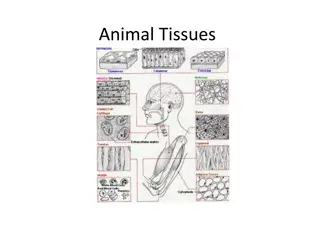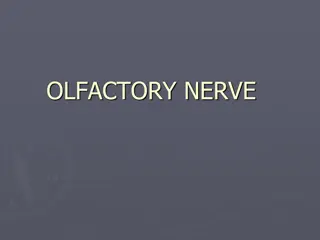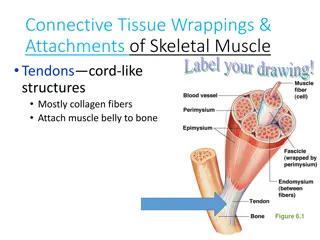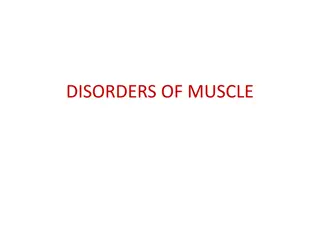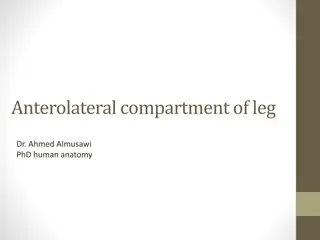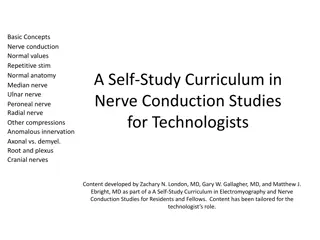Nerve and muscle physiology
The lecture delves into the intricate structure of nerves, highlighting the morphology of nerve fibers and the process of myelination. It explores the classification of nerve fibers, emphasizing the role of dendrites, axons, and synaptic functions in the nervous system. The significance of Schwann cells and oligodendrocytes in myelination is also discussed.
Download Presentation

Please find below an Image/Link to download the presentation.
The content on the website is provided AS IS for your information and personal use only. It may not be sold, licensed, or shared on other websites without obtaining consent from the author.If you encounter any issues during the download, it is possible that the publisher has removed the file from their server.
You are allowed to download the files provided on this website for personal or commercial use, subject to the condition that they are used lawfully. All files are the property of their respective owners.
The content on the website is provided AS IS for your information and personal use only. It may not be sold, licensed, or shared on other websites without obtaining consent from the author.
E N D
Presentation Transcript
Nerve and muscle physiology Lecture 4
Objective for this lecture Expound the nerve fiber morphology, its myelination, and the nerve fiber classification.
The nerve: The human nervous system contains about (100 billion) neurons. A typical nerve cell or neuron has 5-7 processes called dendrites that extend out from the cell body (soma) and arborized extensively .
The dendrites are receptor membrane of the neuron which also has long cytoplasmic extension called the axon (nerve fiber) that originates from a thickened area of the cell body called axon hillock. The axon has a specialized function of conducting impulses away from the dendrites. The axon ends in a number of synaptic knobs (terminal buttons).
The cytosol of the terminal button has two important structures, and these are the [1] Mitochondria [2] Synaptic vesicles. In the synaptic vesicles, transmitter secreted by the nerve is stored. Synthesizing enzymes for neurotransmitters that enter the synaptic cleft are originally formed in the soma. The mitochondria provide ATP, which is required to synthesize new transmitter substance. The wall of terminal button has two important structures, and these are: [1] Voltage-gated Ca2+ channels. [2] Ca2+ pump . Neuron is very sensitive to hypoxia.
Schwann cells are one of the glial cells in the PNS in association with the Satellite cells . In some nerves, a short distance from its origin, the axon acquires a sheath of myelin, which is multiple layers of cellular membrane of Schwann cells containing the lipid substance sphingomyelin enveloping single axon. These types of nerve are called myelinated nerves. About once every mm along the axon, the myelin sheath is interrupted by nods of Ranvier. The end of axon is lack of myelin sheath. Schwann cells are found along peripheral nerves. In the CNS, most neurons are myelinated, but the cells that form the myelin are oligodendrogliocytes rather than Schwann cells. Unlike Schwann cell, oligodendrogliocytes send off multiple processes that form myelin on many adjacent axons rather than wrapping one axon as in Schwann cell. Sphingomyelin is an excellent insulator that prevents almost all flow of ions.
Oligodendrocytes Oligodendrocytes are cells that coat axons in the CNS with their cell membrane forming a myelin sheath, that insulates the axon and is essential for fast transmission of nerve impulses. Defects in this system occur in demyelinating diseases such as Multiple Sclerosis. In contrast to the myelin of the peripheral nervous system, one oligodendrocyte can provide a myelin sheath for several axons.
In addition, voltage-gated Na+ channels are highly concentrated at the nodes of Ranvier. Neurotrophins: They are proteins that are necessary for survival and growth of neurons. Some of these are products of the muscles or other structures that the neurons innervate, but others are produced by Schwann cells and astrocytes. An example of neurotrophins is Nerve Growth Factor (NGF), Brain-Derived Neurotrophic Factor (BDNF). Each maintains a different pattern of neurons and preventing apoptosis. Myelination is important for the following reasons: [1] It increases the excitability of the nerve fiber: This is because the excellent insulation afforded by the myelin membrane substantially minimizes loss of ions and decreases the membrane capacitance about fifty folds. Both effects allow depolarization and repolarization processes to occur with very little transfer of ions (i.e., increase excitability). Consequently, depolarization and repolarization is achieved mainly by the opening and closure of voltage-gated Na+ channels with very little contribution by K+ channels. The capacitance of the membrane per unit length determines the amount of charge required to achieve a certain potential and therefore affects the time needed to reach the threshold (i.e. increase excitability). Large capacitance values, with other parameters remaining the same, mean a slower conduction velocity. [2] It speeds up the conduction velocity of action potential along the nerve fiber by jumping from node to node. This is called saltatory conduction . This mechanism increases the velocity of nerve transmission in myelinated fiber of an average of 5-50 times.
[3] Saltatory conduction conserves energy for the axon, for only the nodes depolarize. The number of Na channels per square micrometer of membrane in myelinated mammalian neurons is maximum in the Node of Ranvier and at the axon Hillock. An axon can conduct in both direction when an action potential is initiated in the middle of it. One along the axon to the terminal buttons (orthodromic conduction) and the other along the axon back to the soma (antidromic conduction). Various diseases of the central and peripheral nervous system (e.g., multiple sclerosis or Guillain-Barre Syndrome) cause groups of myelinated axons in certain areas to lose some or all of their myelin sheath. This demyelination of a segment of an axon causes slowed conduction velocity and, if severe, impulse conduction failure at the site of demyelination.
Factors that affect the conduction velocity: 1. Myelination: myelinated nerve is about 50 times faster. 2. Axon diameter: in unmyelinated nerve axon, the conduction velocity is directly proportional to the square root of axon diameter while in the myelinated neuron conduction velocity increases directly with axon diameter, thus myelination saves considerable space in the nervous system. In small unmyelinated nerve axon, the conduction velocity is about 0.5 meter/second while in the largest myelinated nerve axon it is about 100 meter/second. As diameter increases: 1- Velocity of conduction increases . 2- Magnitude of electrical response increases. 3-Threshold of excitation decreases. 4- Duration of response decreases. 5- Refractory period decreases. 3-Temperature.
Electrical properties of a nerve (nerve trunk): [1] Does not obey the all or none law: This mean that as the stimulus intensity increases, the amplitude of response (action potential) are increased. This is because the average nerve trunk contains about twice as many unmyelinated small nerve fibers as myelinated large nerve fiber. The velocity of conduction in nerve fibers varies from 0.5 m/s in very small unmyelinated fibers to up 100 m/s in very large unmyelinated fibers. The threshold of the individual axons in the nerve and their distance from the stimulating electrodes vary. With subthreshold stimuli, none of the axons are stimulated and no response occurs. When the stimuli are of threshold intensity, axons with low threshold fire and a small potential change is observed. As the intensity of the stimulating current is increased, the axons with higher thresholds are also discharged. The electrical response increases proportionately until the stimulus is strong enough to excite all the axons in the nerve. This stimulus is called maximal stimulus. Further application of greater supramaximal stimuli produces no further increase in the size of the observed potential.
[2] Generation of compound action potential: This mean that as the stimulus intensity increases, the duration of response (action potential) are increased with the appearance of multiple peaks (as opposed to single axons) in the action potential (called compound action potential) . This is due to the fact a mixed nerve is made up of families of fiber with varying speeds of conduction.
Glia: In addition to neurons, the nervous system contains glial cells (neuroglia). There are 10-50 times as many glial cells as neurons. In the peripheral nervous system, there are two types of glial cells: [a] Schwann cells. [b] Satellite cells which are a type of glial cells that surround cell bodies of the neurons in ganglia. Satellite glial cells act as a regulator of neuronal microenvironment like astrocytes in the CNS. In the central nervous system (CNS), there are four main types of glia : [a] Microglia (tissue macrophage) that are scavenger cells that enter the nervous system from the blood vessels. [b] Oligodendrogliocytes that are involved in myelin formation of the CNS neurons. [c] Astrocytes which are found throughout the brain (fibrous astrocytes in the white matter and protoplasmic astrocytes in the gray matter). The main functions of astrocytes are: [1] Astrocytes send processes to the capillary blood vessels to form the tight junctions that contribute to the formation of the Blood-brain barrier (BBB) . [2] They also send processes that envelop synapses and the surface of nerve cells.
[3] They produce substances that are trophic (promoting cellular growth, differentiation, and survival) to neurons. [4] They help maintain the appropriate concentration of substances in the interstitial fluid by taking up K+ ions and neurotransmitters (glutamate and GABA). Without rapid K+ reuptake, [K+ ] increases and depolarizes neuronal resting membrane potentials. [5] To provide neurons with lactate as an energy source. [6] To synthesize neurotransmitter precursors for neurons (e.g., glutamine synthesis for glutaminergic neurons). [d] Ependymal cells are the epithelial-like cells that form a thin epithelial membrane lining the ventricular system of the brain and the spinal cord. It. Ependyma is one of the four types of neuroglia in the central nervous system. It is involved in the production of cerebrospinal fluid (CSF). It is able to act as neural stem cells to regenerate neurons. However, these cells did not self-renew and were subsequently depleted as they generated new neurons, thus failing to satisfy the requirement for stem cells. Therefore, ependymal cells act as reservoir cells in the forebrain, which can be activated after stroke and as in vivo and in vitro stem cells in the spinal cord.
Classification of nerve fibers: [i] The fibers can be classified according to their conduction velocity into the following general types: 1. Type A fibers: They are the typical have a large diameter and they are myelinated fibers of spinal nerves that conduct impulses at high velocities (6-120 m/sec). They include according to the conduction velocity, they subdivided in descending order into: Alpha ( ) fibers (also called type 1a): They are motor fibers to the skeletal muscles (alpha motor neurons), also they the sensory fibers from the skeletal muscles (muscle spindle and Golgi tendon organ) Beta ( ) fibers (also called type 1b): Act as secondary sensory fibers to the skeletal muscle spindle (this information would indicate the position of one's limb once it has stopped moving, i.e. conscious proprioception), and contribute to fine touch, pressure and vibration. Gamma ( ) fibers: They are typically motor neurons that control the intrinsic activation of the skeletal muscle spindle. Delta ( ) fibers: They are free nerve endings that conduct stimuli related to fast pain, touch, pressure, and cold temperature. The susceptibility of the fibers to pressure, hypoxia, and local anesthesia is shown in the table.
2. Type B fiber: They are myelinated fibers that conduct impulses at lower velocity than type A nerve fibers. Generally, they are the preganglionic fibers of the autonomic nervous system (ANS) and have a low conduction velocity. 3. Type C fibers: They are very small unmyelinated nerve fibers that conduct impulses at low velocities. These fibers include Postganglionic fibers in the ANS, nerve fibers at the dorsal roots of the spinal cord (these fibers carry the following sensory information: slow pain, warmth and cold temperature, touch, pressure, itch).
[ii] The fibers can be classified according to the direction in which they conduct impulses. A-Sensory, or afferent neurons , conduct impulses from sensory receptors into the CNS. B-Motor, or efferent neurons conduct impulses out of the CNS to effector organs (muscles and glands). C-Interneurons, are located entirely within the CNS and serve the associative, or integrative functions of the nervous system. There are two types of motor neurons: somatic and autonomic. Somatic motor neurons are responsible for both reflex and voluntary control of skeletal muscles. Autonomic motor neurons innervate (send axons to) the involuntary effectors smooth muscle, cardiac muscle, and glands.
[iii] The structural classification of neurons is based according to the number of processes that extend from the cell body of the neuron : A-Unipolar neurons (also called pseudounipolar neurons) have a single short process that branches like a T to form a pair of longer processes. Sensory neurons are unipolar. One of the branched processes receives sensory stimuli and produces nerve impulses; the other delivers these impulses to synapses within the brain or spinal cord. Anatomically, the part of the process that conducts impulses toward the cell body can be considered a dendrite, and the part that conducts impulses away from the cell body can be considered an axon. Functionally, however, the two branched processes behave as a single long axon; only the small projections at the receptive end of the process function as typical dendrites. B-Bipolar neurons have two processes, one at either end; this type is found in the retina of the eye. C-Multipolar neurons, the most common type, have several dendrites and one axon extending from the cell body; motor neurons are good examples of this type.
Regeneration of peripheral nerve fibers: The PNS can repair and regenerate itself, but the CNS can't repair and regenerate itself. The proximal segment can either die by apoptosis or attempts at repair . The nerve begins the process by destroying the axon distal to the site of injury (Wallerian degeneration) allowing Schwann cells, basal lamina, and the neurilemma near the injury to begin producing a regeneration tube. Nerve growth factors are produced causing many nerve sprouts to bud. When one of the growth processes finds the regeneration tube, it begins to grow rapidly towards its original destination guided the entire time by the regeneration tube. Nerve regeneration is very slow and can take up to several months to complete. While this process does repair some nerves, there will still be some functional deficit as the repairs are not perfect.
